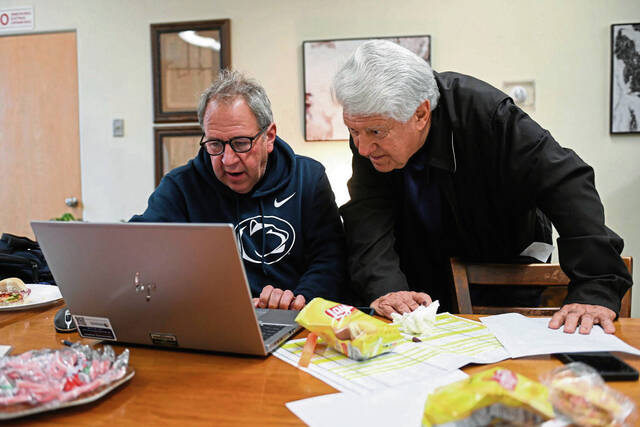Filling the void: major mine subsidence project set for Belle Vernon area
When Tom Wilson was growing up in North Belle Vernon some 60 years ago, he and his friends would sometimes sneak into the opening of an abandoned mine, searching for fossils or some buried treasure.
Fast forward six decades, and Wilson has signed up for a state project to fill some of those voids in the mine where he used to roam by pouring thousands of cubic yards of grout to stabilize the undermined ground beneath his Green Street home and about 230 others.
“I signed on because I think it will be a good thing,” even though he has not experienced mine subsidence, Wilson said. He was among six residents who met with Department of Environment Protection representatives Friday at the North Belle Vernon Municipal Building and gave his consent to do the work at his home.
“You can’t not try to do things better,” Wilson said.
The state is planning a $10.5 million mine subsidence prevention project for Wilson and those 230 other property owners. They live in a 50-block area of North Belle Vernon in Westmoreland County and adjoining Belle Vernon in Fayette County.
It could be the costliest in the state, depending on the number of people participating, said Lauren Camarda, a spokeswoman for the Department of Environmental Protection in Pittsburgh.
The state has selected an area it has determined, based on evidence of mine subsidence, is at a higher risk for property damage caused by the surface collapsing into the voids left decades ago by mining companies.
The high-risk areas for subsidence run along Broad Avenue — the main street in North Belle Vernon — to Blind Lane; between Arch and Locust streets and south of May Street; to Oak Alley and Ella Street, between Blind Lane and April Way.
Just the first phase
The project is expected to begin next year.
It will be just the first phase of the mine subsidence projects in the Belle Vernon area, Camarda said. The federal Infrastructure, Investment and Jobs Act is funding the project, and residents will not have to pay any money.
Most of the impacted area is in North Belle Vernon.
The challenge has been to get people to consent to the drilling on their property, Camarda said. About 30% of the impacted residents have agreed to participate in the project, she said. The project may be scaled back if the participation rate is low, Camarda said.
Wilson’s wife, Tina, was in favor of the project but had questions about it.
“As long as they don’t make damage,” Tina Wilson said, it would be OK with her.
A history of mine subsidence
There has been damage from mine subsidence in the Belle Vernon area over the past 50 years. The Belle Vernon Area High School in Rostraver was damaged by mine subsidence in the 1970s, and several homes in North Belle Vernon were damaged in the 1980s.
The DEP conducted a mine subsidence project around 2002 in the North Belle Vernon and Belle Vernon areas that involved a larger number of affected properties, Camarda said.
“We know there’s a history of it” in the Belle Vernon area, said Eugene Trio, mining engineer with the Bureau of Abandoned Mine Land Reclamation.
The mine subsidence control project typically involves drilling four to six holes around the corners of the residences and pumping a cement-like grout through the holes into the voids — which could be between 30 feet and 150 feet below the surface. The grout solidifies into what Trio said has the same strength as the coal that once was there.
If there is 100% participation in the project, contractors may end up pumping 61,500 cubic yards of grout into the ground.
“What we do is effective,” Trio said. Of the thousands of homes that have been subject to DEP’s mine subsidence projects, problems have occurred in only five, Trio said.
Sam Cover of North Belle Vernon, a borough planning commission member, said he wanted to learn about the mine subsidence control work because he anticipates questions about it. DEP officials have met with borough council to discuss the project and answer questions, Cover said.
Cover’s home is not in the first phase of the project but could be in future phases.
“I think it is a great deal for the town,” said Cover, a longtime resident.
Joe Napsha is a TribLive reporter covering Irwin, North Huntingdon and the Norwin School District. He also writes about business issues. He grew up on Neville Island and has worked at the Trib since the early 1980s. He can be reached at jnapsha@triblive.com.
Remove the ads from your TribLIVE reading experience but still support the journalists who create the content with TribLIVE Ad-Free.


